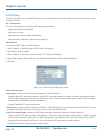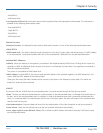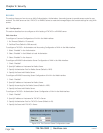
724-746-5500 | blackbox.com
724-746-5500 | blackbox.com
Page 181
Chapter 4: Security
The advantage of MAC-based authentication over port-based 802.1X is that several clients can be connected to the same port
(e.g. through a third party switch or a hub) and still require individual authentication, and that the clients don't need special
supplicant software to authenticate. The advantage of MAC-based authentication over 802.1X-based authentication is that the
clients don't need special supplicant software to authenticate. The disadvantage is that MAC addresses can be spoofed by
malicious users—equipment whose MAC address is a valid RADIUS user can be used by anyone. Also, only the MD5-Challenge
method is supported. The maximum number of clients that can be attached to a port can be limited using the Port Security
Limit Control functionality.
• RADIUS-Assigned QoS Enabled: When RADIUS-Assigned QoS is both globally enabled and enabled (checked) on a given
port, the switch reacts to QoS Class information carried in the RADIUS Access-Accept packet transmitted by the RADIUS server
when a supplicant is successfully authenticated. If present and valid, traffic received on the supplicant's port will be classified to
the given QoS Class. If (re-)authentication fails or the RADIUS Access-Accept packet no longer carries a QoS Class or it's invalid,
or the supplicant is otherwise no longer present on the port, the port's QoS Class is immediately reverted to the original QoS
Class (which may be changed by the administrator in the meanwhile without affecting the RADIUS assigned).
This option is only available for single-client modes, i.e.
- Port-based 802.1X
- Single 802.1X
RADIUS attributes used in identifying a QoS Class:
Refer to the written documentation for a description of the RADIUS attributes needed to successfully identify a QoS Class. The
User-Priority-Table attribute defined in RFC4675 forms the basis for identifying the QoS Class in an Access-Accept packet.
Only the first occurrence of the attribute in the packet will be considered, and to be valid, it must follow this rule:
- All 8 octets in the attribute's value must be identical and consist of ASCII characters in the range '0' - '3', which translates into
the desired QoS Class in the range [0; 3].
• RADIUS-Assigned VLAN Enabled: When RADIUS-Assigned VLAN is both globally enabled and enabled (checked) for a given
port, the switch reacts to VLAN ID information carried in the RADIUS Access-Accept packet transmitted by the RADIUS server
when a supplicant is successfully authenticated. If present and valid, the port's Port VLAN ID will be changed to this VLAN ID,
the port will be set to be a member of that VLAN ID, and the port will be forced into VLAN unaware mode. Once assigned, all
traffic arriving on the port will be classified and switched on the RADIUS-assigned VLAN ID.
If (re-)authentication fails or the RADIUS Access-Accept packet no longer carries a VLAN ID or it's invalid, or the supplicant is
otherwise no longer present on the port, the port's VLAN ID is immediately reverted to the original VLAN ID (which may be
changed by the administrator in the meanwhile without affecting the RADIUS-assigned).
This option is only available for single-client modes, i.e.
- Port-based 802.1X
- Single 802.1X
For troubleshooting VLAN assignments, use the "Monitor --> VLANs --> VLAN Membership and VLAN Port" pages. These
pages show which modules have (temporarily) overridden the current Port VLAN configuration.
RADIUS attributes used in identifying a VLAN ID: RFC2868 and RFC3580 form the basis for the attributes used in identifying a
VLAN ID in an Access-Accept packet. The following criteria are used:
- The Tunnel-Medium-Type, Tunnel-Type, and Tunnel-Private-Group-ID attributes must all be present at least once in the Access-
Accept packet.
- The switch looks for the first set of these attributes that have the same Tag value and fulfill the following requirements (if Tag
== 0 is used, the Tunnel-Private-Group-ID does not need to include a Tag):
- Value of Tunnel-Medium-Type must be set to “IEEE-802“ (ordinal 6).
LGB1108A


















